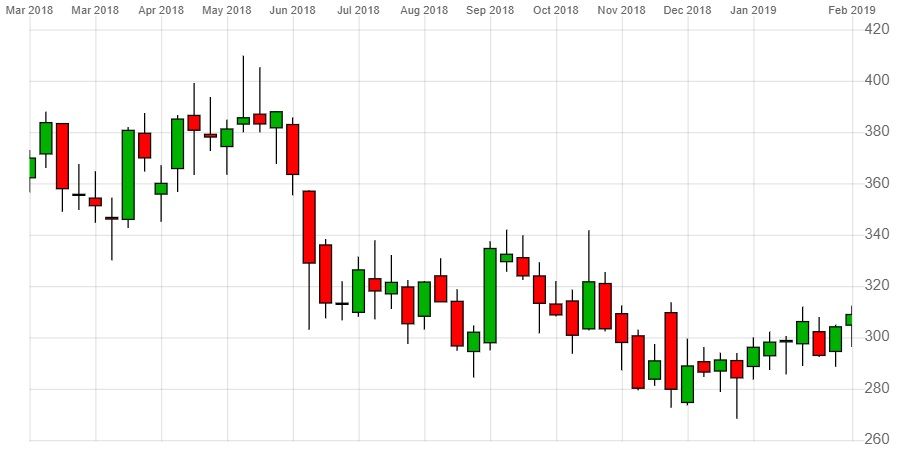With a $54bn market cap and $8.3bn in profits for the first-half of 2018,
Glencore [GLEN] is the largest mining company in the world by revenue. The firm’s share price has had a solid start to 2019, gaining over 10%.
However, it is currently trading 25% off its 2018 high reached in January. After an initial upwards sprint at the start of last year, despite some fluctuations, H1 was largely consistent for the stock.
But things changed in July 2018 after the mining giant was hit by a money laundering probe from the US Department of Justice, sending its share price south by as much as 19% over the week ensuing. The company was dragged into the Brazilian car wash investigation by the end of the year as well.
In an effort to keep investors and traders on side, Glencore switched its focus from deal making to a share buyback programme that saw it repurchase up to $1bn of stock in July and, another $1bn in December. Its dividend also tripled year-on-year, rising to $0.10 for both halves of 2018.
$0.10
Glencore dividend in both halves of 2018
The decline in the company’s share price has meant that the stock currently offers a forward dividend yield of 5.26% and a price to earnings ratio of 6.91, which is attracting the attention of analysts with 12 out of 22 financial institutions holding ‘buy’ ratings for the stock.
Since its IPO of 531.10p in 2011, Glencore’s share price has fallen 41%, it trades at 307.00p (at the time of writing).
Oil and gas underpin earnings growth
The massive price swings and oversupply warnings in oil impacted Glencore’s crude production in 2018, as it fell by 8% to 4.6 million barrels. Coal production meanwhile was 7% higher than in 2017 at 129.4 million tonnes.
The global commodities market as a whole was the best performing asset class in 2018 after oil prices were slashed. Commodity prices particularly rallied when the US Federal Reserve signalled a slowing of interest rate rises and a lowered risk of recession, pushing Goldman Sachs towards an ‘overweight’ rating for the sector.
Goldman also said European commodities and mining equities were “attractively positioned,” expecting a 10% rate of return in 2019.
However, the suspense over the US-China trade talks continues to affect oil markets in the run up to 1 March.
10%
Goldman's expected rate of return for European commodities and mining equities in 2019
“Resumption of the US-China trade talks has prompted risk-appetite in financial markets, which has also manifested in oil prices gaining strength,” Abhishek Kumar, analyst at Interfax Energy, said. “Nevertheless, there needs to be a tangible outcome from the talks for a sustained rally in prices.”
Glencore plans to capitalise on battery mineral growth
Recently, Glencore has begun targeting the renewable energy trend in electric vehicles as a key growth driver.
Rapid advances in battery chemistry and tumbling prices has seen the energy-storage market boom. The market is expected to attract $620bn in investment over the next 22 years. Glencore is working to position itself as a core supplier.
Rechargeable batteries used in electric vehicles are primarily made up of nickel and zinc, which increased in production by 13% and 2% respectively in 2018.
The company expects 25%, 30% and 133% growth by 2020 in its copper, nickel and cobalt production respectively.
Glencore’s wider mining production meanwhile for 2018 saw copper 11% higher than in 2017, due to its Democratic Republic of Congo operations recommencing, which had a knock-on effect with its cobalt production that soared 54% higher than 2017 – the highest increase out of all its mineral sources.
| Market cap | £42.07bn |
| PE ratio (TTM) | 12.76 |
| EPS (TTM) | 24.00 |
| Payout ratio | 83.81% |
Glencore stock vitals, Yahoo finance, as at 1 March 2019
Changing of the old guard
CEO Ivan Glasenberg, who helped make the company into a dominant force in commodities trading while also becoming the face of the industry, is set to retire in the next three to five years.
The exit of Glasenberg will mark a generational shift at the top as he looks for a younger CEO to take his spot.
The leadership upheaval also signifies the company’s changing face as it transitions into new areas in a bid to attract new growth and a stronger share price performance.
Continue reading for FREE






